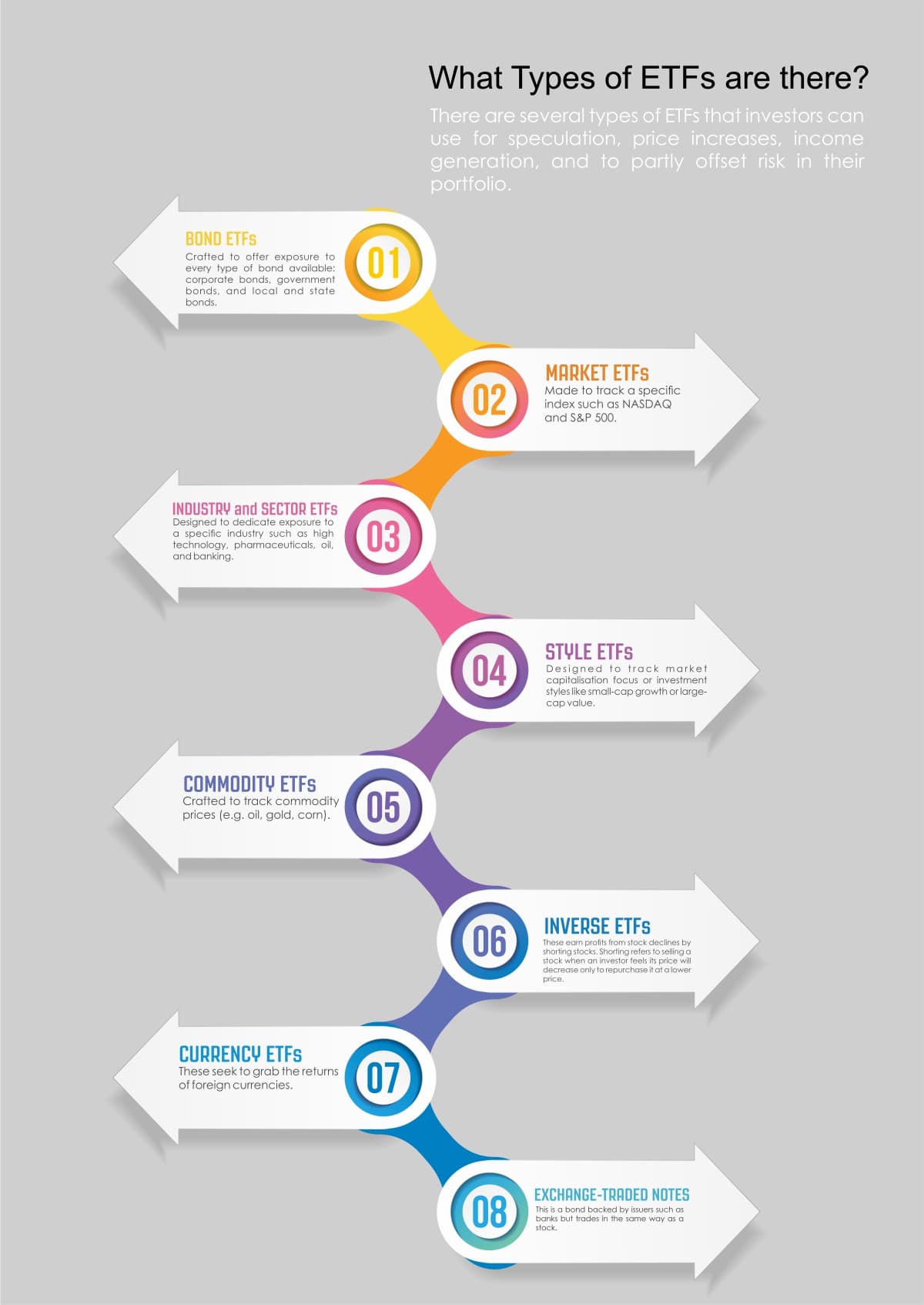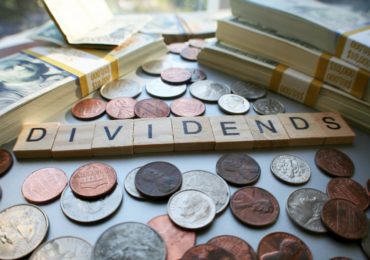Detailed Guide On What Are ETFs In Trading
If you are into Forex, you must have heard about exchange-traded funds (ETFs). Do you know what are ETFs? They are amongst the most valuable and important products created for individual investors in recent years. If used wisely, ETFs are an excellent vehicle for the fulfilment of an investor’s investment goals.
An ETF is a basket of securities that can be bought or sold through a brokerage organisation on the stock exchange. ETFs are offered on every conceivable asset class from alternative assets such as currencies or commodities to traditional investments. Moreover, innovative ETF structures allow investors to gain leverage, short markets, and prevent against short-term capital gains taxes.
ETFs began in 1993 after a couple of unsuccessful starts, with the product popularly known by its symbol, SPY, or Spiders, which grew into the highest volume ETF in history. It is estimated that more than $1 trillion is invested in ETFs and approximately 1,000 ETF products are traded on the US stock exchange.
Since ETFs are traded on exchanges exactly like stocks, they are called exchange-traded funds. Just like a stock’s price fluctuates throughout the trading day, ETFs prices also change. They are different from mutual funds as mutual funds are not traded on an exchange and are traded only once a day after the market closes.
What Types of ETFs are there?
Once knowing what are ETFs, we realise that there are several types of ETFs that investors can use for speculation, price increases, income generation, and to partly offset risk in their portfolio.
- Bond ETFs: Crafted to offer exposure to every type of bond available: corporate bonds, government bonds, and local and state bonds.
- Market ETFs: Made to track a specific index such as NASDAQ and S&P 500.
- Industry and sector ETFs: Designed to dedicate exposure to a specific industry such as high technology, pharmaceuticals, oil, and banking.
- Style ETFs: Designed to track market capitalisation focus or investment styles like small-cap growth or large-cap value.
- Commodity ETFs: Crafted to track commodity prices (e.g. oil, gold, corn).
- Inverse ETFs: These earn profits from stock declines by shorting stocks. Shorting refers to selling a stock when an investor feels its price will decrease only to repurchase it at a lower price.
- Currency ETFs: These seek to grab the returns of foreign currencies.
- Exchange-traded notes: This is a bond backed by issuers such as banks but trades in the same way as a stock.

How Are ETFs Different From Mutual Funds?
It is important to know how mutual funds and ETFs are different from each other to understand ETFs. However, first, it is important to learn about their similarities.
- They are diversified investments: Both ETFs and mutual funds allow investors to purchase a basket of securities within a single investment. They both typically invest within an implied or stated objective, such as value, income, or growth, and they generally invest in a specific category of bonds or stocks, such as foreign stocks, larger capital stocks, or immediate term bonds.
- The majority of ETFs function like index mutual funds: The majority of ETFs are passively managed, which makes them very similar to index mutual funds. Because of this, both the ETF and index fund can reflect the performance of an underlying asset such as S&P 500; both have very low expense ratios compared to actively-managed funds and both of them can be prudent investments for portfolio construction and diversification.
There are multiple differences between the two. If you are planning to invest in either of them, understanding their differences is crucial. To further understand what ETFs are, please read the following points.
- ETFs trade intraday while mutual funds trade at the end of the day
The price at which you sell or buy a mutual fund is not the price but net asset value (NAV) of the underlying asset. You will trade at the mutual fund’s NAV at the end of the day. So, if the price of a stock falls or rises during the day, you will not be able to control the timing of the execution of the trade.
In contrast, exchange-traded funds are traded intraday. This can be beneficial if you wish to take advantage of the price movements that take place during the day. However, the market will not necessarily move according to your wishes. For example, you may assume that the price will rise during the day and, therefore, buy the ETF in the morning; however, although you would gain if the price was to rise, if the price fell, you would lose.
- You can make stock orders with ETFs but not with mutual funds
ETFs can place stock orders that can help overcome a few pricing and behavioural risks associated with day trading. For instance, with a limited order, you can select a price at which a trade is conducted. With a stop order, you can select the price under the current price and avoid a loss below the selected price. Mutual funds do not offer such flexible control.
- The expense ratio in the case of ETFs is lower than that of mutual funds
ETFs have lower expense ratio than most mutual funds and can, at times, have expenses that are lower than those of index mutual funds. This can, in theory, offer a slim edge in returns over index funds for you. However, ETFs can have greater trading costs. For instance, imagine that you have a brokerage account with XYZ investments. If you choose to trade an iShares ETF, you might pay £5 as a trading fee; however, the same firm’s index fund pursuing the same index has no commission or transaction fee.
How Do ETFs Work?
To understand what are ETFs, it is important to know how they work. An ETF is sold and bought like a company stock when the stock exchanges are open during the day. An ETF has a ticker symbol like a stock and intraday price data can be simply obtained during the course of a trading day.
Unlike a company’s stock, an ETF’s outstanding number of shares can change daily due to the continuous creation of new shares as well as the redemption of existing ones. The market prices of ETFs are kept in line with their underlying securities due to their ability to continuously redeem and issue shares.
Institutional investors play an important role in tracking integrity and maintaining the liquidity of the ETF through the sale and purchase of creation units, which are huge blocks of ETF shares that can be traded for baskets of underlying securities, even though they are designed for individual investors.
When an ETF’s price deviates from the underlying asset value, institutions use the arbitrage mechanism afforded by creation units to force the ETF price back into line with its underlying asset value.
Do ETFs pay dividends?
Payouts to shareholders or dividends are paid out by ETFs every three months. The amount of dividend relies on the percentage of shares investors own in the fund. Some ETFs, however, do not give away dividends. For instance, fixed income ETFs offer interest instead.
Two types of dividends are issued – non-qualified and qualified dividends. Their difference depends on how long stocks are held within the ETF and how they are taxed.
- Qualified dividends are paid on stocks held by the ETF. The investor must have owned the shares for more than 60 days during the 121-day period, which starts 60 days prior to the ex-dividend date. They are taxed at the capital gains tax rate.
- Non-qualified dividends are taxed at ordinary income rates.
What Are the Advantages of ETFs?
Cost
Among the advantages of ETFs, low cost is the biggest. As ETF shareholders are not required to pay a manager or a team of brokers and analysts to buy and sell funds from their end, as well as do not manage fund outflows and inflows, ETFs usually have much lower expense ratios compared to traditional mutual funds. Even their expense ratios tend to be lower than open-end index funds. This is because open-end index funds need to retain an adequate number of staff to process continuous purchases and redemptions.
For example, many large-cap mutual funds ask for expense ratios of 80 basis points or at least 0.8% per year. Investors’ shares of open-end mutual funds usually have an expense ratio of between 19 and 50 basis points, which rely on the index. Investor shares of S&P 500 or other large-cap index funds can charge between 18 and 20 basis points. However, large-cap ETF may charge nearer to 10 to 15 basis points, on a continuous basis.
However, you also need to account for the expenses of trading. When you sell or buy a closed-end fund or an ETF, you will be required to pay a commission to the broker.
Short selling
A list of ETF disadvantages would be incomplete without mentioning their ability to short sell. You cannot engage in short selling with open-end funds, which is the practice of borrowing and selling shares with the expectation that share prices will fall. When the price does fall, the short seller will buy the shares again at the new price and will then give them back to the original owner, observing the difference.
Liquidity
When you purchase an open-ended mutual fund, you are only allowed to fund shares once a day as their NAV when the market closes. You cannot sell or buy shares during the day. So, if you own an open-ended fund and listen to unfavourable news in the morning after the opening of the markets, you cannot sell them until the market closes. Similarly, you cannot purchase them if you hear favourable news the next day.
Closed-ended mutual funds and ETFs can be sold throughout the day via stock exchanges, although some funds are traded more often than others. It is easier to find a willing seller or buyer quickly if funds are traded more frequently. Thus, liquidity is one of the main ETF advantages.
Tax Considerations and Low Turnover
Index funds, as well as ETFs, tend to be ideal and highly tax-efficient for holding taxable accounts. This is because portfolio turnover is very low in index funds, whereas managers of actively managed funds buy and sell securities every time they see a better investment idea. ETFs and index funds, however, buy shares only when they are included in the index, and sell shares when new securities are excluded from the index.
Every time funds sell a share at a profit, the IRS assesses capital gains tax, which is passed on to shareholders. Since ITFs and index funds do not sell shares frequently, it is very rare for them to make a taxable distribution for their shareholders.
In-Kind Distribution
ETFs have the option of creaking an in-kind distribution to shareholders. This implies that they can immediately deliver securities from the portfolio to the shareholders and make the trades themselves.
However, income is taxable if the ETF’s portfolio produces dividend income, just like it is in the case of open-ended and closed-ended mutual funds.
Lack Of Redemptions
ETFs are more tax-efficient compared to open-ended index funds; ETFs do not have to sell securities to meet redemptions. This function is performed by the open market and the ETF’s staff remains out of the picture.
No Cash Drag
Index fund portfolios attempt to imitate an index as closely as possible. Thus, they own an extremely low level of cash in their portfolios. They are fully invested at all times. This works in their favour in the escalating markets. ETFs have zero concern regarding meeting redemptions, so they can manage with almost no cash in hand. However, in falling markets, such a position affects the fund as the portfolio bears the brunt of the market decline.
What Are the Disadvantages of ETFs?
Small Discounts
When fund shares get exchanged in the open market instead of being redeemed directly from the fund company, the investors determine the share prices. The prices can be lower or higher than the combined value of the shares in the portfolio.
With closed-ended funds, it is often possible to purchase fund shares with an up to 15% discount to NAV, whereas with ETFs, discounts are close to being non-existent.
No DRIPs
Many investors demand to automatically reinvest dividends in fund shares, in a dividend reinvestment plan (DRIP). However, this is generally not done with ETFs, as it would need excessive fund administration and would increase fund costs.
Conclusion
What are ETFs? A simple answer would be that they are tradable instruments that track an index, bonds, commodity, or an entire basket of assets such as the index fund. Trading in ETFs is becoming increasingly popular because they can be used to gain exposure in practically any market or any industry sector in the world.
You can invest your assets in a traditional fashion using bond ETFs and the stock index, and you can adjust the allocation according to the changes in your goals and risk tolerance. You can even add alternative commodity assets such as gold. You can trade throughout the day to benefit from price movements. ETFs provide complete flexibility and are preferred by more investors.











